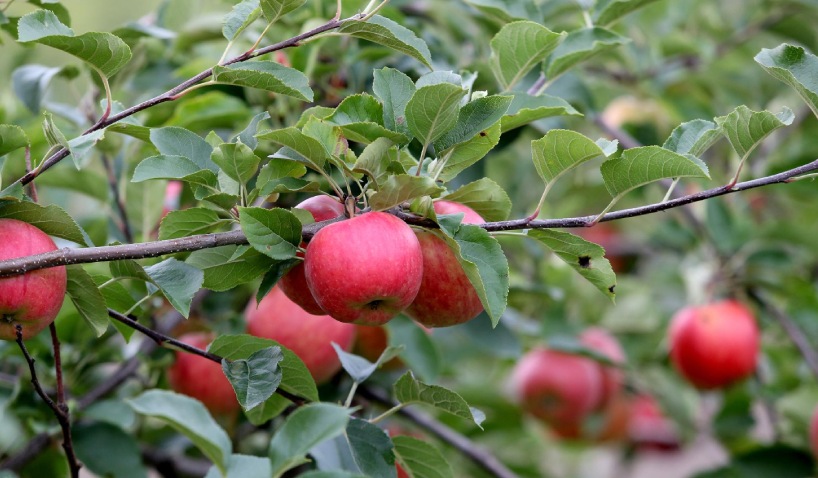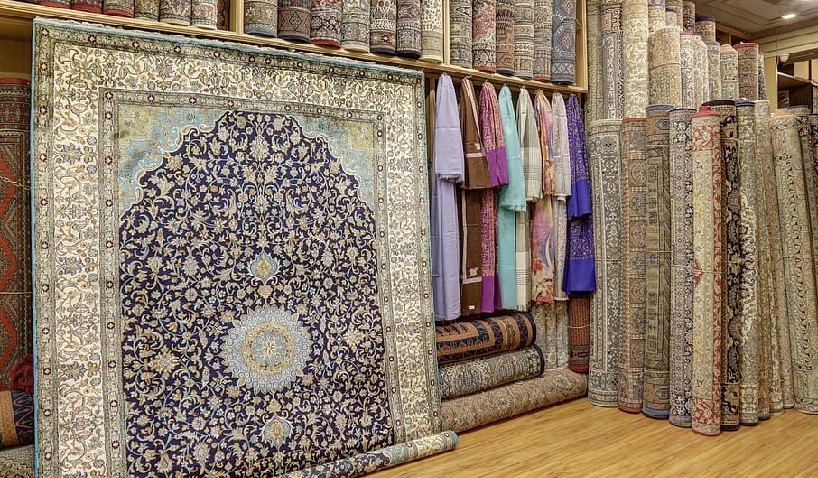Kashmir’s Paper Mache – Unlocking the Mysteries
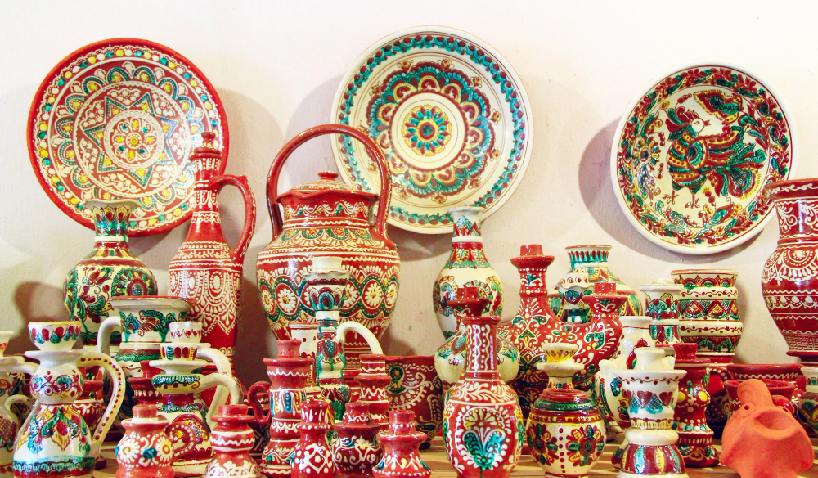
Paper mache, a celebrated craft originating from Persia and flourishing in the valleys of Kashmir, India, stands as a testament to the ingenuity and artistic finesse of its craftsmen. The term itself, derived from the French words “papier” (paper) and “mâché” (mashed or chewed), encapsulates the essence of this age-old technique that transforms humble materials into breathtaking works of art. In Kashmir, paper mache is not merely a craft; it is a cherished tradition that weaves together history, culture, and creativity.
Origins and Heritage : The roots of paper mache in Kashmir can be traced back to the 15th century when skilled artisans from Persia introduced the technique to the region. Over the centuries, Kashmiri craftsmen honed their skills, elevating paper mache to a revered art form. Today, this tradition is deeply embedded in the cultural fabric of Kashmir, reflecting the region’s rich heritage and artistic prowess.
Artistic Excellence : What sets Kashmiri paper mache apart is its exquisite craftsmanship and attention to detail. Artisans meticulously mold and shape paper pulp into a myriad of forms, ranging from delicate figurines to elaborate decorative pieces. The designs, often inspired by nature, mythology, and Islamic art, are rendered with precision and finesse, showcasing the artisans’ mastery of their craft. Each piece is a testament to the rich artistic heritage of Kashmir and the dedication of its craftsmen.
Symbolism and Significance : Beyond its aesthetic appeal, paper mache holds deep symbolic significance in Kashmiri culture. It is intertwined with religious rituals, weddings, and other ceremonial occasions, serving as both a functional object and a cultural artifact. The motifs and patterns adorning paper mache pieces carry profound meaning, reflecting the region’s cultural identity and spiritual beliefs. Through its symbolism, paper mache becomes a vehicle for storytelling and expression, preserving the narratives of generations past.
Economic Contribution : In addition to its cultural importance, paper mache plays a vital economic role in Kashmir. It provides livelihoods for numerous artisans and sustains local communities, particularly in rural areas where the craft is deeply rooted. The demand for Kashmiri paper mache products extends beyond regional borders, contributing to the region’s economy and fostering cultural exchange.
Origins and Heritage : The roots of paper mache in Kashmir can be traced back to the 15th century when skilled artisans from Persia introduced the technique to the region. Over the centuries, Kashmiri craftsmen honed their skills, elevating paper mache to a revered art form. Today, this tradition is deeply embedded in the cultural fabric of Kashmir, reflecting the region’s rich heritage and artistic prowess.
Artistic Excellence : What sets Kashmiri paper mache apart is its exquisite craftsmanship and attention to detail. Artisans meticulously mold and shape paper pulp into a myriad of forms, ranging from delicate figurines to elaborate decorative pieces. The designs, often inspired by nature, mythology, and Islamic art, are rendered with precision and finesse, showcasing the artisans’ mastery of their craft. Each piece is a testament to the rich artistic heritage of Kashmir and the dedication of its craftsmen.
Symbolism and Significance : Beyond its aesthetic appeal, paper mache holds deep symbolic significance in Kashmiri culture. It is intertwined with religious rituals, weddings, and other ceremonial occasions, serving as both a functional object and a cultural artifact. The motifs and patterns adorning paper mache pieces carry profound meaning, reflecting the region’s cultural identity and spiritual beliefs. Through its symbolism, paper mache becomes a vehicle for storytelling and expression, preserving the narratives of generations past.
Economic Contribution : In addition to its cultural importance, paper mache plays a vital economic role in Kashmir. It provides livelihoods for numerous artisans and sustains local communities, particularly in rural areas where the craft is deeply rooted. The demand for Kashmiri paper mache products extends beyond regional borders, contributing to the region’s economy and fostering cultural exchange.
History of Paper Mache in Kashmir:
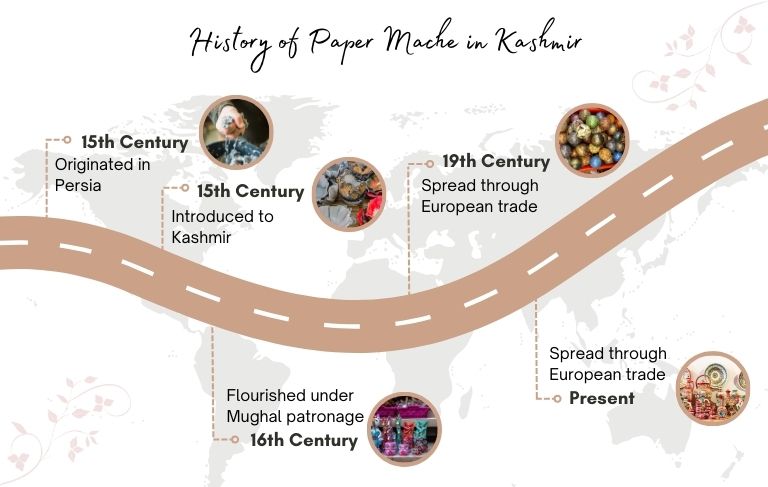
Paper mache, also known as “Kar-i-kalamdan” in Persian, has a rich and storied history in the picturesque valleys of Kashmir, India. Its origins can be traced back to the 15th century when Persian artisans brought this craft to the region during the reign of Sultan Zain-ul-Abidin, also known as Budshah. Under his patronage, the art of paper mache began to take root and flourish in the fertile soil of Kashmir’s artistic heritage.
Initially, paper mache was used to create small, utilitarian objects such as pen stands, boxes, and trays. These items were crafted using a paste made from soaked and beaten paper pulp, mixed with glue and other natural ingredients. The artisans then molded and sculpted this paste into intricate designs, often inspired by Persian and Central Asian motifs.
The craft of paper mache received a significant boost during the Mughal era, particularly under the patronage of Emperor Akbar. Recognizing the artistic potential of Kashmiri artisans, Akbar invited them to his court in Agra and Lahore, where they showcased their skills and introduced the craft to a wider audience. This royal patronage helped elevate paper mache to new heights of creativity and sophistication.
The 17th and 18th centuries are considered the golden age of Kashmiri paper mache. During this period, the craft flourished under the patronage of Mughal emperors and local nobility. Artisans experimented with new techniques and designs, creating masterpieces that adorned royal palaces and wealthy households. The intricate patterns and vibrant colors of Kashmiri paper mache became synonymous with luxury and refinement.
With the opening of trade routes to Europe in the 19th century, Kashmiri paper mache gained popularity in Western markets. European travelers and traders marveled at the exquisite craftsmanship of Kashmiri artisans, leading to increased demand for paper mache products abroad. However, the rise of industrialization posed challenges to traditional handicrafts like paper mache, as mass-produced goods from factories began to compete with handmade items.
Despite these challenges, Kashmiri paper mache has endured, thanks to the resilience of its artisans and efforts to preserve traditional craftsmanship. Today, it remains an integral part of Kashmir’s cultural heritage, admired for its beauty, intricacy, and artistic significance. Whether as decorative pieces or functional objects, Kashmiri paper mache continues to captivate hearts and minds around the world, carrying forward a legacy that spans centuries.
Initially, paper mache was used to create small, utilitarian objects such as pen stands, boxes, and trays. These items were crafted using a paste made from soaked and beaten paper pulp, mixed with glue and other natural ingredients. The artisans then molded and sculpted this paste into intricate designs, often inspired by Persian and Central Asian motifs.
The craft of paper mache received a significant boost during the Mughal era, particularly under the patronage of Emperor Akbar. Recognizing the artistic potential of Kashmiri artisans, Akbar invited them to his court in Agra and Lahore, where they showcased their skills and introduced the craft to a wider audience. This royal patronage helped elevate paper mache to new heights of creativity and sophistication.
The 17th and 18th centuries are considered the golden age of Kashmiri paper mache. During this period, the craft flourished under the patronage of Mughal emperors and local nobility. Artisans experimented with new techniques and designs, creating masterpieces that adorned royal palaces and wealthy households. The intricate patterns and vibrant colors of Kashmiri paper mache became synonymous with luxury and refinement.
With the opening of trade routes to Europe in the 19th century, Kashmiri paper mache gained popularity in Western markets. European travelers and traders marveled at the exquisite craftsmanship of Kashmiri artisans, leading to increased demand for paper mache products abroad. However, the rise of industrialization posed challenges to traditional handicrafts like paper mache, as mass-produced goods from factories began to compete with handmade items.
Despite these challenges, Kashmiri paper mache has endured, thanks to the resilience of its artisans and efforts to preserve traditional craftsmanship. Today, it remains an integral part of Kashmir’s cultural heritage, admired for its beauty, intricacy, and artistic significance. Whether as decorative pieces or functional objects, Kashmiri paper mache continues to captivate hearts and minds around the world, carrying forward a legacy that spans centuries.
Key Points
- Introduced by Persian artisans in the 15th century during the reign of Sultan Zain-ul-Abidin.
- Early development focused on small decorative objects.
- Patronage by Mughal emperors, especially Emperor Akbar, contributed to the craft’s growth.
- Flourished during the 17th and 18th centuries, known as the golden age of Kashmiri paper mache.
- Gained popularity in Europe in the 19th century due to increased trade.
- Faced challenges from industrialization in the late 19th and early 20th centuries.
Artisan Techniques and Process of Paper Mache
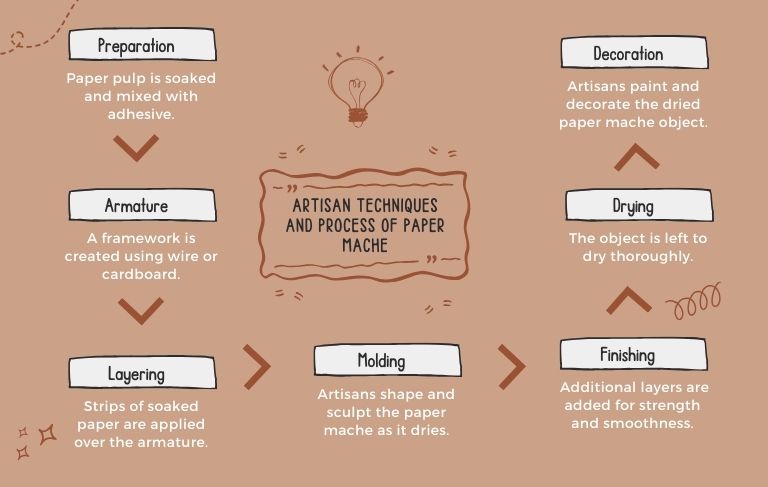
The process of crafting paper mache involves several intricate techniques that have been refined over centuries by skilled artisans. Here’s a brief overview of the typical steps involved:
Preparation of Base Material: The process begins with the preparation of the base material, which is usually paper pulp. This pulp is made by soaking paper scraps or pulp in water until it becomes soft and pliable. Creation of Armature: Next, artisans create an armature or framework using materials such as wire, cardboard, or even clay. This armature serves as the foundation for the paper mache object and determines its shape and structure.
Layering with Paper Strips: Strips of paper are then dipped in a glue mixture, often made from water and flour or other adhesive substances. These soaked paper strips are then applied layer by layer over the armature, gradually building up the desired form.
Molding and Sculpting: As the layers of paper dry, artisans mold and sculpt the material to achieve the desired shape and texture. This process requires skill and precision to ensure that the final product meets the artist’s vision. Finishing Touches: Once the paper mache object has taken shape, artisans apply additional layers of paper and glue to strengthen and smooth the surface. They may also add decorative elements or embellishments during this stage.
Drying and Sealing: After the final layers have been applied, the paper mache object is left to dry thoroughly. Depending on the size and complexity of the piece, this may take several days or even weeks. Once dry, the object is often sealed with a varnish or sealant to protect it from moisture and wear.
Painting and Decoration: Finally, artisans paint and decorate the paper mache object using a variety of techniques, including hand-painting, stenciling, or decoupage. This stage allows for personal expression and creativity, as artisans imbue each piece with unique colors, patterns, and designs.
Through these meticulous techniques and processes, artisans transform simple materials into exquisite works of art, showcasing the beauty and versatility of paper mache.
Preparation of Base Material: The process begins with the preparation of the base material, which is usually paper pulp. This pulp is made by soaking paper scraps or pulp in water until it becomes soft and pliable. Creation of Armature: Next, artisans create an armature or framework using materials such as wire, cardboard, or even clay. This armature serves as the foundation for the paper mache object and determines its shape and structure.
Layering with Paper Strips: Strips of paper are then dipped in a glue mixture, often made from water and flour or other adhesive substances. These soaked paper strips are then applied layer by layer over the armature, gradually building up the desired form.
Molding and Sculpting: As the layers of paper dry, artisans mold and sculpt the material to achieve the desired shape and texture. This process requires skill and precision to ensure that the final product meets the artist’s vision. Finishing Touches: Once the paper mache object has taken shape, artisans apply additional layers of paper and glue to strengthen and smooth the surface. They may also add decorative elements or embellishments during this stage.
Drying and Sealing: After the final layers have been applied, the paper mache object is left to dry thoroughly. Depending on the size and complexity of the piece, this may take several days or even weeks. Once dry, the object is often sealed with a varnish or sealant to protect it from moisture and wear.
Painting and Decoration: Finally, artisans paint and decorate the paper mache object using a variety of techniques, including hand-painting, stenciling, or decoupage. This stage allows for personal expression and creativity, as artisans imbue each piece with unique colors, patterns, and designs.
Through these meticulous techniques and processes, artisans transform simple materials into exquisite works of art, showcasing the beauty and versatility of paper mache.
Significance and Symbolism
The cultural and symbolic significance of paper mache in Kashmir is deeply ingrained in the region’s rich heritage and traditions. Here’s an exploration of how paper mache is utilized in various aspects of Kashmiri life:
Religious Ceremonies: Paper mache plays a significant role in religious ceremonies and rituals in Kashmir. Decorative items such as trays, bowls, and containers crafted from paper mache are often used to hold offerings during religious ceremonies, including weddings, festivals, and prayers. These intricately designed objects are considered auspicious and symbolize reverence and devotion.
Weddings: In Kashmiri weddings, paper mache items are an essential part of the traditional dowry exchange. Elaborate paper mache chests, boxes, and decorative pieces are meticulously crafted and exchanged between the bride and groom’s families as symbols of prosperity, love, and goodwill. These intricately designed items often feature motifs inspired by Kashmiri culture and folklore, adding to the festive ambiance of the wedding celebrations.
Everyday Life: Beyond religious ceremonies and weddings, paper mache is woven into the fabric of everyday life in Kashmir. From household decor to personal accessories, paper mache products are cherished for their beauty and craftsmanship. Decorative items such as vases, trays, and figurines adorn Kashmiri homes, adding a touch of elegance and tradition to interior spaces. Additionally, paper mache jewelry boxes, keychains, and ornaments are popular souvenirs and gifts, showcasing the artistry and cultural heritage of Kashmir.
Symbolism: The intricate designs and motifs found in Kashmiri paper mache carry deep symbolic significance. Floral patterns, paisleys, and geometric shapes often adorn paper mache objects, symbolizing prosperity, fertility, and protection. Additionally, motifs inspired by nature, such as birds, flowers, and trees, reflect Kashmir’s scenic landscapes and spiritual connections to the natural world. Each design tells a story and conveys cultural values and beliefs, making paper mache not just decorative art but a reflection of Kashmiri identity and tradition.
In essence, paper mache in Kashmir transcends its utilitarian function to become a symbol of cultural pride, artistic expression, and spiritual significance. Its presence in religious ceremonies, weddings, and everyday life underscores its integral role in preserving and perpetuating Kashmir’s rich cultural heritage for generations to come.
Religious Ceremonies: Paper mache plays a significant role in religious ceremonies and rituals in Kashmir. Decorative items such as trays, bowls, and containers crafted from paper mache are often used to hold offerings during religious ceremonies, including weddings, festivals, and prayers. These intricately designed objects are considered auspicious and symbolize reverence and devotion.
Weddings: In Kashmiri weddings, paper mache items are an essential part of the traditional dowry exchange. Elaborate paper mache chests, boxes, and decorative pieces are meticulously crafted and exchanged between the bride and groom’s families as symbols of prosperity, love, and goodwill. These intricately designed items often feature motifs inspired by Kashmiri culture and folklore, adding to the festive ambiance of the wedding celebrations.
Everyday Life: Beyond religious ceremonies and weddings, paper mache is woven into the fabric of everyday life in Kashmir. From household decor to personal accessories, paper mache products are cherished for their beauty and craftsmanship. Decorative items such as vases, trays, and figurines adorn Kashmiri homes, adding a touch of elegance and tradition to interior spaces. Additionally, paper mache jewelry boxes, keychains, and ornaments are popular souvenirs and gifts, showcasing the artistry and cultural heritage of Kashmir.
Symbolism: The intricate designs and motifs found in Kashmiri paper mache carry deep symbolic significance. Floral patterns, paisleys, and geometric shapes often adorn paper mache objects, symbolizing prosperity, fertility, and protection. Additionally, motifs inspired by nature, such as birds, flowers, and trees, reflect Kashmir’s scenic landscapes and spiritual connections to the natural world. Each design tells a story and conveys cultural values and beliefs, making paper mache not just decorative art but a reflection of Kashmiri identity and tradition.
In essence, paper mache in Kashmir transcends its utilitarian function to become a symbol of cultural pride, artistic expression, and spiritual significance. Its presence in religious ceremonies, weddings, and everyday life underscores its integral role in preserving and perpetuating Kashmir’s rich cultural heritage for generations to come.
Contemporary Applications of Paper Mache
In recent years, paper mache has seen significant changes, blending its traditional methods with modern influences. Here’s how it’s evolved:
Modern Designs: Today, artisans are mixing traditional techniques with contemporary styles. They’re creating sleeker shapes, simpler designs, and experimenting with vibrant colors and abstract patterns. This modern touch attracts younger audiences and broadens paper mache’s appeal.
Global Presence: Paper mache from Kashmir is now reaching global markets. Through online platforms, social media, and international expos, artisans are showcasing their work worldwide. People everywhere are drawn to its unique beauty, cultural significance, and eco-friendly nature.
Preservation Efforts: Even with modernization, efforts are ongoing to protect traditional methods. Various organizations provide training and support to artisans, ensuring traditional skills are passed down. There’s also a focus on reviving endangered designs and conserving natural resources, keeping the essence of paper mache alive.
In essence, while embracing contemporary trends and reaching global markets, paper mache artisans are committed to preserving their rich heritage, ensuring that this timeless craft continues to thrive for generations to come.
Modern Designs: Today, artisans are mixing traditional techniques with contemporary styles. They’re creating sleeker shapes, simpler designs, and experimenting with vibrant colors and abstract patterns. This modern touch attracts younger audiences and broadens paper mache’s appeal.
Global Presence: Paper mache from Kashmir is now reaching global markets. Through online platforms, social media, and international expos, artisans are showcasing their work worldwide. People everywhere are drawn to its unique beauty, cultural significance, and eco-friendly nature.
Preservation Efforts: Even with modernization, efforts are ongoing to protect traditional methods. Various organizations provide training and support to artisans, ensuring traditional skills are passed down. There’s also a focus on reviving endangered designs and conserving natural resources, keeping the essence of paper mache alive.
In essence, while embracing contemporary trends and reaching global markets, paper mache artisans are committed to preserving their rich heritage, ensuring that this timeless craft continues to thrive for generations to come.
Showcase of Masterpieces Paper Mache
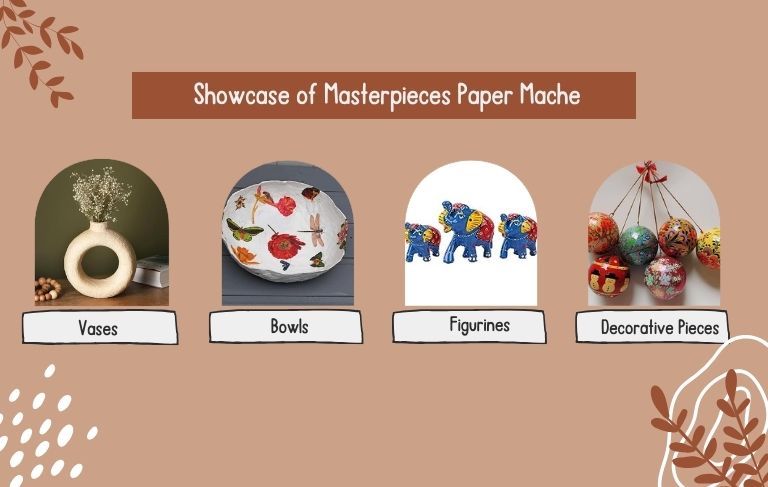
Here are some notable examples of paper mache artwork and renowned artisans:
Vases:
Artisan: Abdul Ahad JanDescription: Abdul Ahad Jan is known for his exquisite paper mache vases adorned with intricate floral patterns and vibrant colors. His creations showcase a perfect blend of traditional Kashmiri motifs and contemporary design elements, making them highly sought after by collectors worldwide.
Bowls:
Artisan: Shameem AhmedDescription: Abdul Ahad Jan is known for his exquisite paper mache vases adorned with intricate floral patterns and vibrant colors. His creations showcase a perfect blend of traditional Kashmiri motifs and contemporary design elements, making them highly sought after by collectors worldwide.
Figurines:
Artisan: Muzaffar JanDescription: Abdul Ahad Jan is known for his exquisite paper mache vases adorned with intricate floral patterns and vibrant colors. His creations showcase a perfect blend of traditional Kashmiri motifs and contemporary design elements, making them highly sought after by collectors worldwide.
Decorative Pieces:
Artisan: Nusrat JehanDescription: Nusrat Jehan is known for her innovative approach to paper mache, creating unique decorative pieces that blend traditional craftsmanship with modern aesthetics. From ornate wall hangings to intricately designed masks and sculptures, her creations are celebrated for their artistic ingenuity and attention to detail.
Essential Tips for Collecting Paper Mache Art
Identifying Authenticity
- Look for intricate hand-painted designs : Authentic Kashmiri paper mache products feature meticulously hand-painted designs with fine details and vibrant colors.
- Feel the texture : Genuine paper mache has a smooth, slightly textured surface. Run your fingers over the piece to feel its quality and craftsmanship.
- Check for weight : Kashmiri paper mache is lightweight due to its paper pulp base. If the product feels excessively heavy, it may not be authentic.
- Seek artisan signatures : Some artisans sign their work, adding authenticity to the piece. Look for signatures or marks indicating the artisan’s name or workshop.
Purchasing Tips
- Buy from reputable sellers: Purchase paper mache products from trusted sellers or certified artisans to ensure authenticity and quality.
- Ask about materials and techniques: Inquire about the materials used and the techniques employed in crafting the piece. Authentic Kashmiri paper mache is made from natural materials and crafted using traditional methods.
- Inspect for flaws: Examine the product carefully for any imperfections or flaws, such as cracks, chips, or uneven paintwork. Authentic pieces are usually flawlessly crafted.
Caring for Collections:
- Handle with care: Paper mache is delicate, so handle your collection with care to avoid damage. Avoid dropping or mishandling the pieces.
- Keep away from moisture: Paper mache is susceptible to moisture damage. Display your collection in a dry, well-ventilated area away from direct sunlight, humidity, and water sources.
- Dust regularly: Dust your paper mache collection regularly with a soft, dry cloth to keep it clean and free from dirt and debris.
- Avoid harsh cleaning agents:Do not use harsh chemicals or abrasive cleaners on paper mache, as they can damage the surface. Instead, gently wipe with a damp cloth if necessary.
Displaying Collections:
- Showcase in well-lit areas: Display your paper mache collection in well-lit areas to highlight its intricate details and vibrant colors.
- Use display stands or shelves: Consider using display stands or shelves to showcase your collection, allowing each piece to be prominently featured and appreciated.
- Rotate periodically:Rotate your paper mache pieces periodically to prevent fading and ensure even exposure to light and air.
